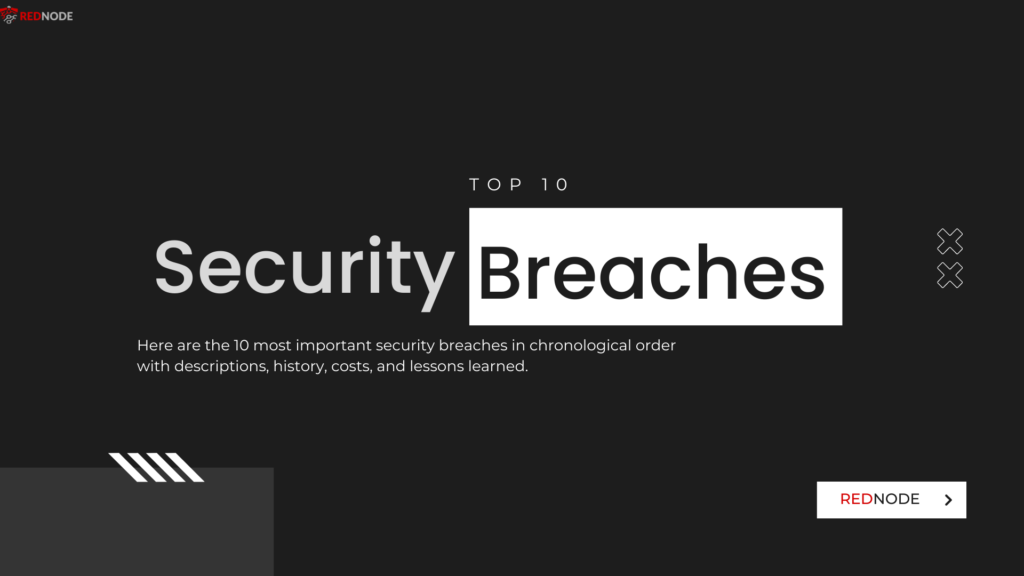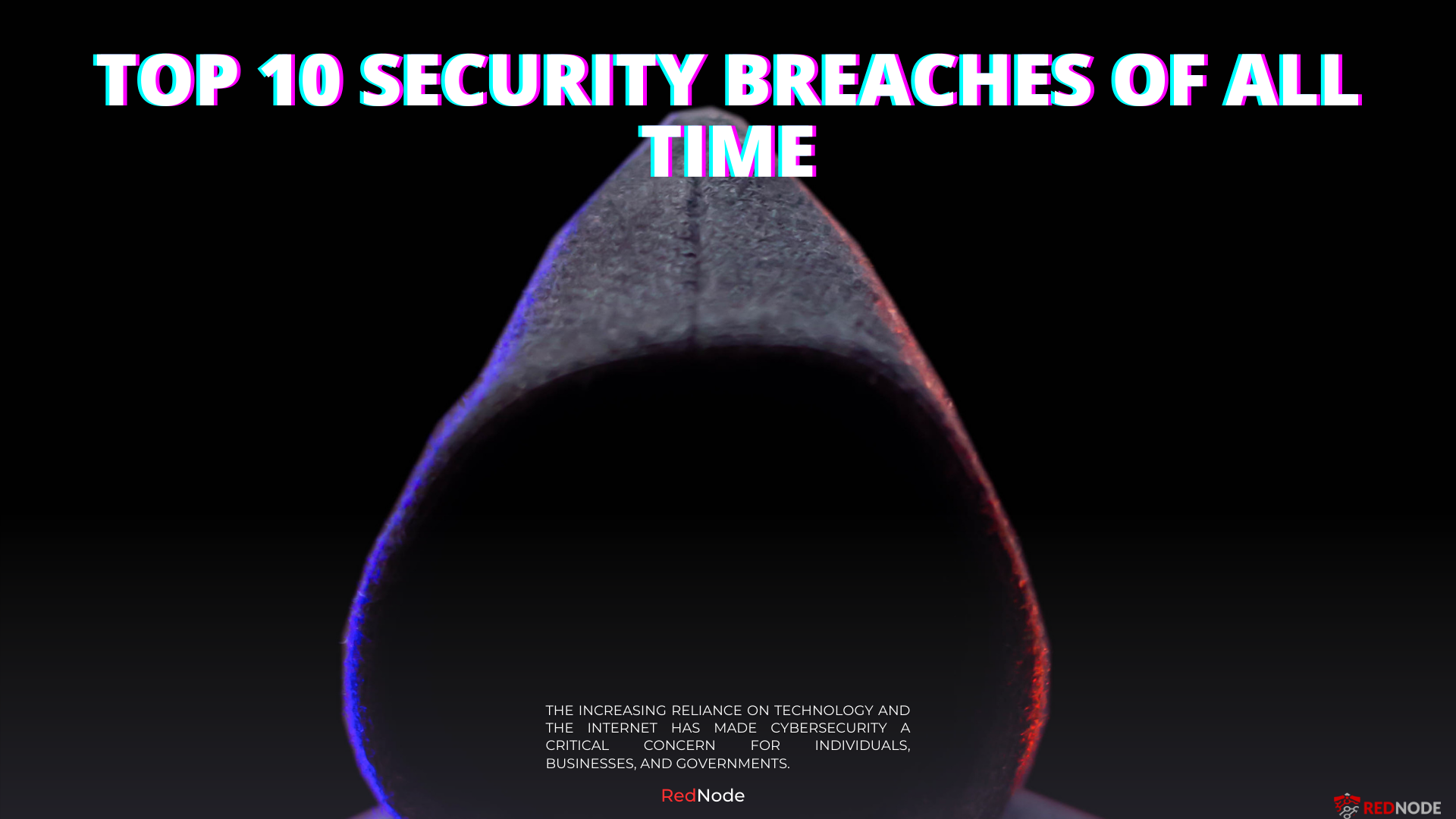In today’s digital landscape, security breaches have become a prevalent threat to individuals, organizations, and even nations. The repercussions of these breaches extend beyond the usual consequences of financial loss, reputational damage, legal consequences, and compromised privacy. In this article, we delve into the history of cybersecurity to highlight the top 10 security breaches of all time, each leaving an indelible mark on the world. From the early Morris worm to the infamous SolarWinds supply chain attack, these events have shaped the cybersecurity landscape and underscored the critical importance of strong defenses.
Table of Contents

All Top Security Breaches
Here are the 10 most important security breaches in chronological order with descriptions, history, costs, and lessons learned:
Morris Worm (1988):
Description: The Morris Worm was one of the earliest computer worms, created by Robert Tapan Morris. It exploited vulnerabilities in Unix systems, infecting thousands of computers.
History: The worm spread rapidly, causing significant network congestion and system crashes.
Cost: Estimated damage is about $100,000 to $10 million.
Lesson: This incident highlights the importance of security measures, leading to advancements in cyber security practices.
AOL Data Leak (2004):
Description: In 2004, America Online (AOL) suffered a data breach that exposed more than 92 million user search queries with personally identifiable information.
History: AOL released anonymous search logs, but researchers were able to identify individuals based on queries.
Cost: The breach led to privacy concerns and damage to AOL’s reputation.
Lesson: Anonymous data is not foolproof, and companies should carefully consider the potential risks when handling sensitive user data.
TJX Company (2005):
Description: The TJX Company, including T.J. Max & Marshalls, suffered a massive breach where hackers gained access to customer data, including credit card information.
History: The breach went undetected for over a year, during which millions of customer records were stolen.
Costs: Total costs, including settlements, fines, and legal fees, exceed $256 million.
Lesson: Effective monitoring and detection systems are critical to promptly detect and respond to security incidents
Heartland Payment System (2008):
Description: Hackers targeted payment processing company Heartland Payment Systems and installed malware on their systems, leading to the theft of billions of credit card details.
History: The breach highlighted weaknesses in the payment processing industry, particularly related to the storage and transmission of cardholder data.
Costs: Breach-related costs cost the company more than $140 million.
Lesson: Compliance with industry security standards, such as the Payment Card Industry Data Security Standard (PCI DSS), is critical for organizations handling sensitive financial data.
Sony PlayStation Network (2011):
Description: Sony’s PlayStation Network (PSN) was breached, compromising the personal information of approximately 77 million users, including credit card details.
History: The breach resulted in the temporary shutdown of PSN for several weeks and significant damage to Sony’s reputation.
Cost: The breach cost Sony an estimated $171 million.
Lesson: Strong security measures, including encryption and intrusion detection systems, are essential to protecting user data.
Target (2013):
Description: Target, a major retailer, experienced a breach in which attackers gained access to their network through a third-party vendor and stole payment card information from millions of customers.
History: Attackers used stolen vendor credentials to gain access to the target’s systems and install malware on point-of-sale terminals.
Costs: More than $200 million targeted, including settlements, legal fees, and remediation efforts for the breach.
Lesson: Strong vendor management and regular security assessments of third-party partners are essential to prevent supply chain attacks.
Equifax (2017):
Description: Equifax, one of the largest credit reporting agencies, suffered a breach in which cybercriminals exploited a vulnerability to access sensitive personal information, including the Social Security numbers of 147 million customers.
History: The breach was attributed to the company’s failure to patch a known vulnerability in a web application.
Cost: The total cost of the breach exceeded $1.4 billion.
Lesson: Timely application of security patches and vulnerability management are critical to prevent the exploitation of known vulnerabilities.
WannaCry Ransomware (2017):
Description: The WannaCry ransomware attack spread globally, infecting hundreds of thousands of computers, disrupting critical systems such as healthcare and transportation, and encrypting users’ files.
History: The attack exploited a vulnerability in older Windows systems using a leaked NSA exploit.
Cost: Total damage and recovery costs reach billions of dollars.
Lessons: Regular software updates, strong cybersecurity hygiene, and effective incident response planning are critical to mitigating the impact of ransomware attacks.
Cambridge Analytica (2018):
Description: The Cambridge Analytica scandal involved the unauthorized access and misuse of Facebook user data by a third-party organization, which used Facebook’s API to collect personal information without users’ consent.
History: The data was used for targeted political advertising during the 2016 US presidential election.
Cost: Facebook has faced significant fines, legal action, and reputational damage.
Lesson: Protecting user privacy and ensuring proper consent processes for data collection is critical in an age of social media and third-party integration.
SolarWinds Supply Chain Attack (2020):
Description: Cyber attackers compromised the software supply chain of SolarWinds, a prominent IT management software provider, allowing them to distribute a trojanized update that affected many organizations.
History: Attackers gained access to SolarWinds’ build environment and injected malicious code into software updates, enabling them to conduct widespread espionage.
Cost: The total cost and impact of the attack is still being assessed but is expected to be substantial.
Lesson: Organizations must prioritize the security of their supply chains and implement strict controls to prevent and detect unauthorized changes to software and updates.
These breaches serve as a reminder that cybersecurity is an ongoing battle, and organizations must remain vigilant, prioritize security measures, and constantly adapt to emerging threats.
Conclusion:
These top 10 security breaches represent watershed moments in the history of cybersecurity, having an indelible impact on every individual, organization, and society as a whole. As technology evolves and threats become more sophisticated, these breaches serve as stark reminders that cybersecurity must be a top priority. Lessons learned from these incidents will continue to shape the strategies and defenses employed in the ongoing battle against cybercrime, with the ultimate goal of creating a safer and more secure digital world.

